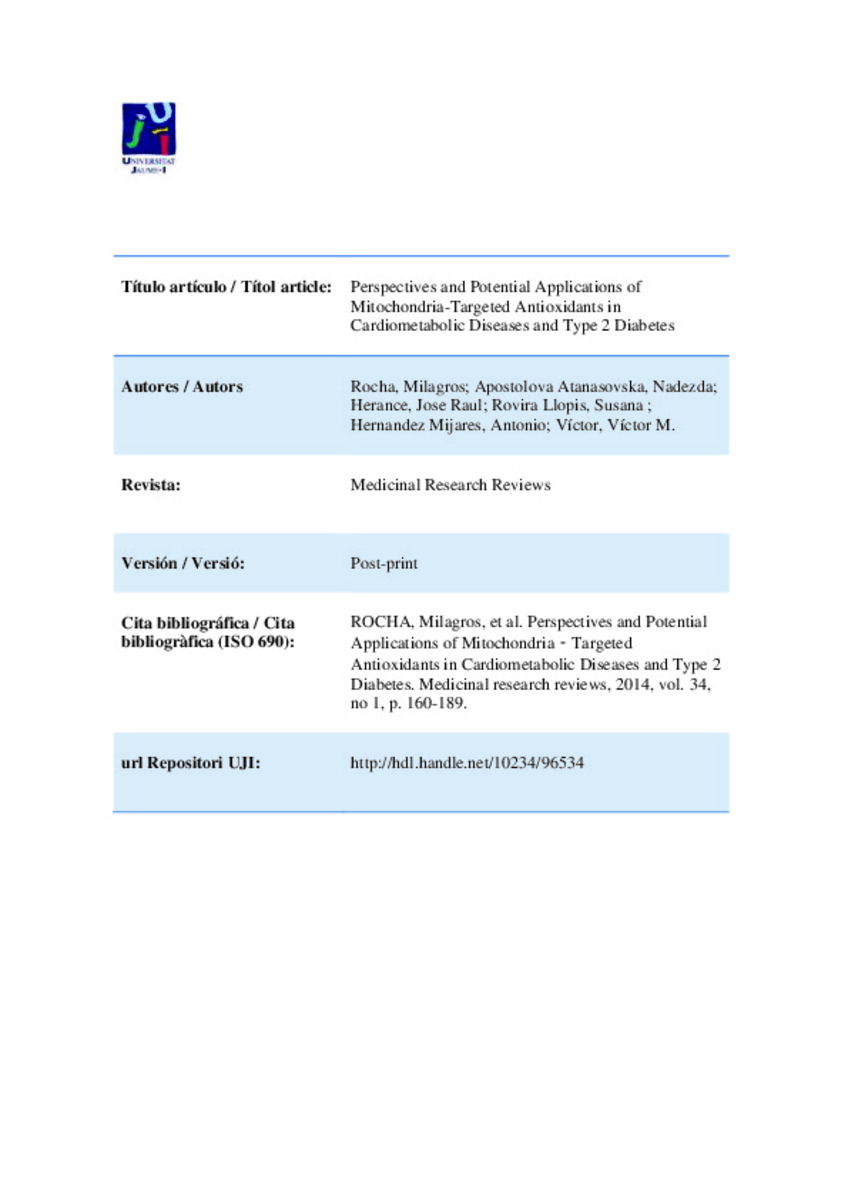Mostrar el registro sencillo del ítem
Perspectives and Potential Applications of Mitochondria-Targeted Antioxidants in Cardiometabolic Diseases and Type 2 Diabetes
| dc.contributor.author | Rocha, Milagros | |
| dc.contributor.author | Apostolova, Nadezda | |
| dc.contributor.author | Herance, Jose Raul | |
| dc.contributor.author | Rovira Llopis, Susana | |
| dc.contributor.author | Hernández Mijares, Antonio | |
| dc.contributor.author | Víctor, Víctor M. | |
| dc.date.accessioned | 2014-06-30T10:29:29Z | |
| dc.date.available | 2014-06-30T10:29:29Z | |
| dc.date.issued | 2013 | |
| dc.identifier.citation | ROCHA, Milagros, et al. Perspectives and Potential Applications of Mitochondria‐Targeted Antioxidants in Cardiometabolic Diseases and Type 2 Diabetes. Medicinal research reviews, 2014, vol. 34, no 1, p. 160-189. | ca_CA |
| dc.identifier.issn | 0198-6325 | |
| dc.identifier.issn | 1098-1128 | |
| dc.identifier.uri | http://hdl.handle.net/10234/96534 | |
| dc.description.abstract | There is abundant evidence to suggest that mitochondrial dysfunction is a main cause of insulin resistance and related cardiometabolic comorbidities. On the other hand, insulin resistance is one of the main characteristics of type 2 diabetes, obesity, and metabolic syndrome. Lipid and glucose metabolism require mitochondria to generate energy, and when O2 consumption is low due to inefficient nutrient oxidation, there is an increase in reactive oxygen species, which can impair different types of molecules, including DNA, lipids, proteins, and carbohydrates, thereby inducing proinflammatory processes. Factors which contribute to mitochondrial dysfunction, such as mitochondrial biogenesis and genetics, can also lead to insulin resistance in different insulin-target tissues, and its association with mitochondrial dysfunction can culminate in the development of cardiovascular diseases. In this context, therapies that improve mitochondrial function may also improve insulin resistance. This review explains mechanisms of mitochondrial function related to the pathological effects of insulin resistance in different tissues. The pathogenesis of cardiometabolic diseases will be explained from a mitochondrial perspective and the potential beneficial effects of mitochondria-targeted antioxidants as a therapy for modulating mitochondrial function in cardiometabolic diseases, especially diabetes, will also be considered. | ca_CA |
| dc.description.sponsorShip | Contract grant sponsor: PI10/1195; Contract grant sponsor: PI 12/1984; Contract grant sponsor: CIBERehd CB06/04/0071; Contract grant sponsor: PROMETEO 2010/060; Contract grant sponsor: ACOMP/2012/042; Contract grant sponsor: ACOMP/2012/045; Contract grant sponsor: ACOMP2013/061; Contract grant sponsor: European Regional Development Fund (ERDF). | ca_CA |
| dc.format.extent | 30 p. | ca_CA |
| dc.language.iso | eng | ca_CA |
| dc.publisher | John Wiley & Sons | ca_CA |
| dc.relation.isPartOf | Medicinal research reviews (2014) vol. 34, no 1 | ca_CA |
| dc.rights | Copyright © John Wiley & Sons | ca_CA |
| dc.rights.uri | http://rightsstatements.org/vocab/InC/1.0/ | * |
| dc.subject | Cardiometabolic disease | ca_CA |
| dc.subject | Diabetes | ca_CA |
| dc.subject | Insulin resistance | ca_CA |
| dc.subject | Mitochondria | ca_CA |
| dc.subject | Oxidative stress | ca_CA |
| dc.title | Perspectives and Potential Applications of Mitochondria-Targeted Antioxidants in Cardiometabolic Diseases and Type 2 Diabetes | ca_CA |
| dc.type | info:eu-repo/semantics/article | ca_CA |
| dc.identifier.doi | http://dx.doi.org/10.1002/med.21285 | |
| dc.rights.accessRights | info:eu-repo/semantics/openAccess | ca_CA |
| dc.relation.publisherVersion | http://onlinelibrary.wiley.com/doi/10.1002/med.21285/full | ca_CA |
| dc.type.version | info:eu-repo/semantics/acceptedVersion |
Ficheros en el ítem
Este ítem aparece en la(s) siguiente(s) colección(ones)
-
MED_Articles [655]
Articles de publicacions periòdiques







